Energy
3.1 Environmental Impacts of the Grand Coulee Hydroelectric Dam
Chris Ebersole
Hydroelectric power plants, such as the Grand Coulee Dam, provide benefits such as renewable energy and irrigation, but also produce adverse costs to human and wildlife populations. Careful consideration must be given before a hydroelectric power plant can be responsibly implemented.
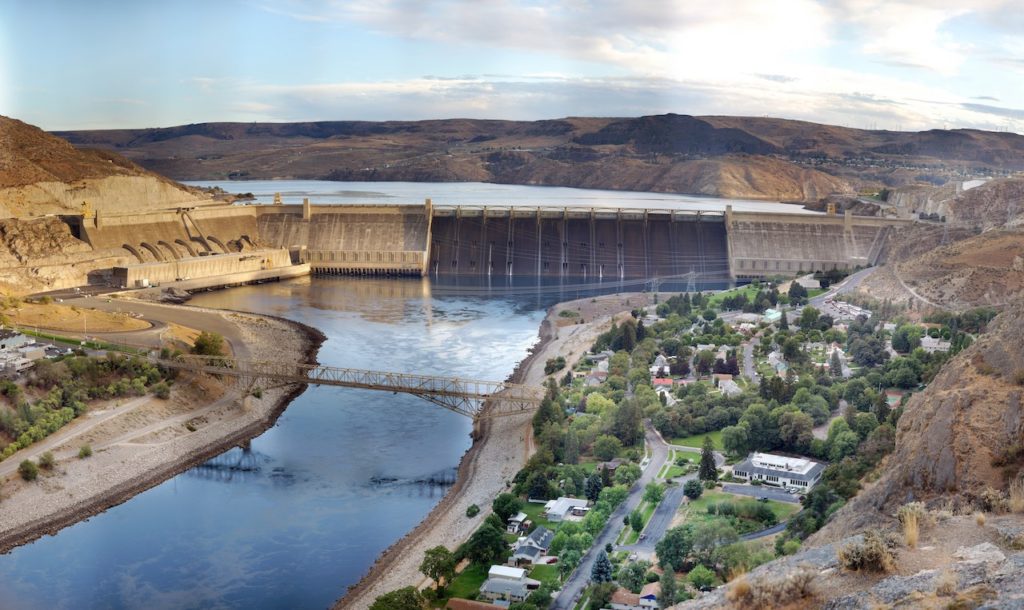
Photograph by Gregg M Erickson, 2009. CC BY 3.0.
Hydroelectric power plants provide a very efficient, renewable method of generating electricity without producing air pollution. Hydroelectric produced electricity currently accounts for nearly 7% of the total electricity generated in the United States. However, currently less than 3% of all dams in the United States are used to generate electricity.3 This discrepancy presents a great opportunity to increase the use of renewable energy production through hydroelectric power.3 There are many factors which make hydroelectric energy a desirable alternative to the burning of fossil fuels, yet the construction and operation of hydroelectric plants also involves a number of disadvantages. These drawbacks include environmental changes which could adversely affect the health of humans and animals.
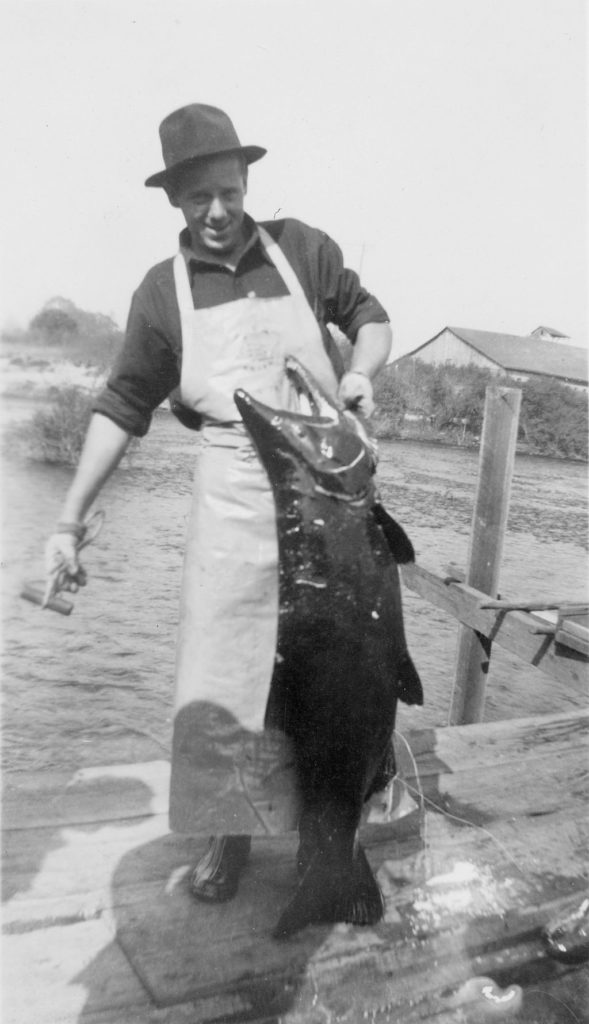
Photograph from Oregon State Special Collections and Archives, 2004. Public Domain.
To produce electricity, hydroelectric power plants harness the gravitational energy of falling water to turn turbines. This process is similar to burning coal, which creates steam used to turn turbines. Hydroelectric turbines are connected to a generator which translates this rotational mechanical energy into electrical energy through Faraday’s Law (Figure 3). In accordance with this law, a generator’s rotor is made to behave as an electromagnet. When the wicket gates are opened and water causes the rotor connected to the turbine to spin, these magnets move past conductors mounted in the stator, resulting in the flow of electricity. For this process to be effective, water must be stored at a high elevation and released at a low elevation to yield the maximum gravitational energy, thus hydroelectric dams are constructed on rivers to form a high-elevation reservoir behind the dam.

Courtesy of U.S. Army Corps of Engineers, 2012. Public Domain.
Demand for electricity fluctuates from day to day and month to month. During periods of low demand, such as nighttime, stored electricity can be used to pump water up into a backup reservoir. This process allows for the recycling of water in hydroelectric production. Pumped storage systems allow for rapid adjustments in plant output, resulting in a more efficient system which is relatively inexpensive to build.11
The Grand Coulee Dam, located on the Columbia River 145 km west of Spokane, Washington, is three times the size of the Great Pyramid and two and a half times the volume of Hoover Dam (Figure 1, 4).1 Constructed between 1933 and 1942, the Grand Coulee Dam was a major source of economic stimulus during the Great Depression. Construction of the dam provided roughly 8,800 jobs, and resulted in a large economic boom in neighboring towns.9 Since its completion, the Grand Coulee Dam has provided many long-term jobs, annual irrigation to more than 2,000 Washington farmers, and is one of the top producers of hydroelectric power in the United States. The revenue produced by this dam has far outweighed its cost. The Grand Coulee Dam was vital in providing the electricity necessary to produce aluminum for airplanes and plutonium for nuclear weapons during World War II.9 With the addition of a third power plant in 1974, the Grand Coulee Dam is now capable of producing 7,200 megawatts of power.7
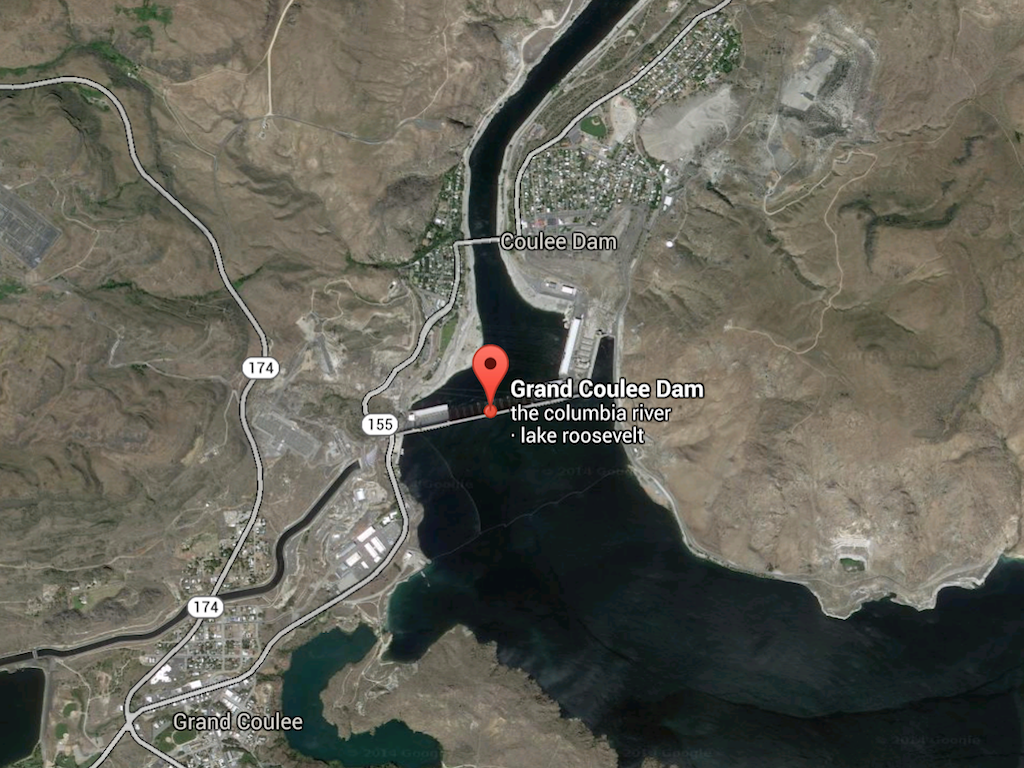
Map data ©2015 Google. Public Domain.
Click Here to Explore the Grand Coulee Dam in Google Maps
Despite the many economic opportunities provided by the Grand Coulee Dam, there are a number of detriments which limit its overall utility. Hydroelectric dams alter the environment in numerous ways which include altering natural hydrographs, diverting waterways, changing abiotic factors such as water temperature, and changing biotic factors such as secondary productivity.10 The construction of a series of dams on the Columbia River, including the Grand Coulee Dam, has limited the available riverine salmon habitat to 13% of the river.2 Fall chinook salmon currently use only 85 km of the 2,000 km river as breeding grounds.2 The first two of the fourteen hydroelectric dams built on the Columbia River included fish ladders which allowed anadromous salmonids to travel through the dams.2 Dams constructed later, including the Grand Coulee Dam, were not constructed with this feature.2 At the start of the 20th century, an estimated 10 to 16 million anadromous fish runs occurred annually in the Columbia River.2 Currently, an estimated average of 2.5 million runs occur each year.2 In addition, hydroelectric dams can cause changes in food and water security, an increase in communicable diseases among humans and animals, social disruption caused by construction and involuntary resettlement, and a loss of biodiversity (Figure 5).8
From 1995 to 2004, a study was conducted by McLellan et al. (2011) to determine if a correlation exists between reservoir elevation fluctuations and the rainbow trout (Figure 6) population in Franklin D. Roosevelt Lake. This lake was created by the Grand Coulee Dam blocking the flow of the Columbia River (Figure 3).10 Since 1987, 500,000 coastal rainbow trout have been stocked annually in the lake. Some of these fish were marked using Floy Tags before being released into the lake and anglers were asked to return the tags of any fish caught. The fewest return of tags occurred during deep drawdown events, in which the elevation of the reservoir was lowered to less than 372 meters. These events are typically used as a method of flood control between February and May. During this time period the reservoir experiences its lowest annual elevations. The findings of the McLellan et al. (2011) study suggest a correlation between deep drawdown events and fish entrainment and mortality.
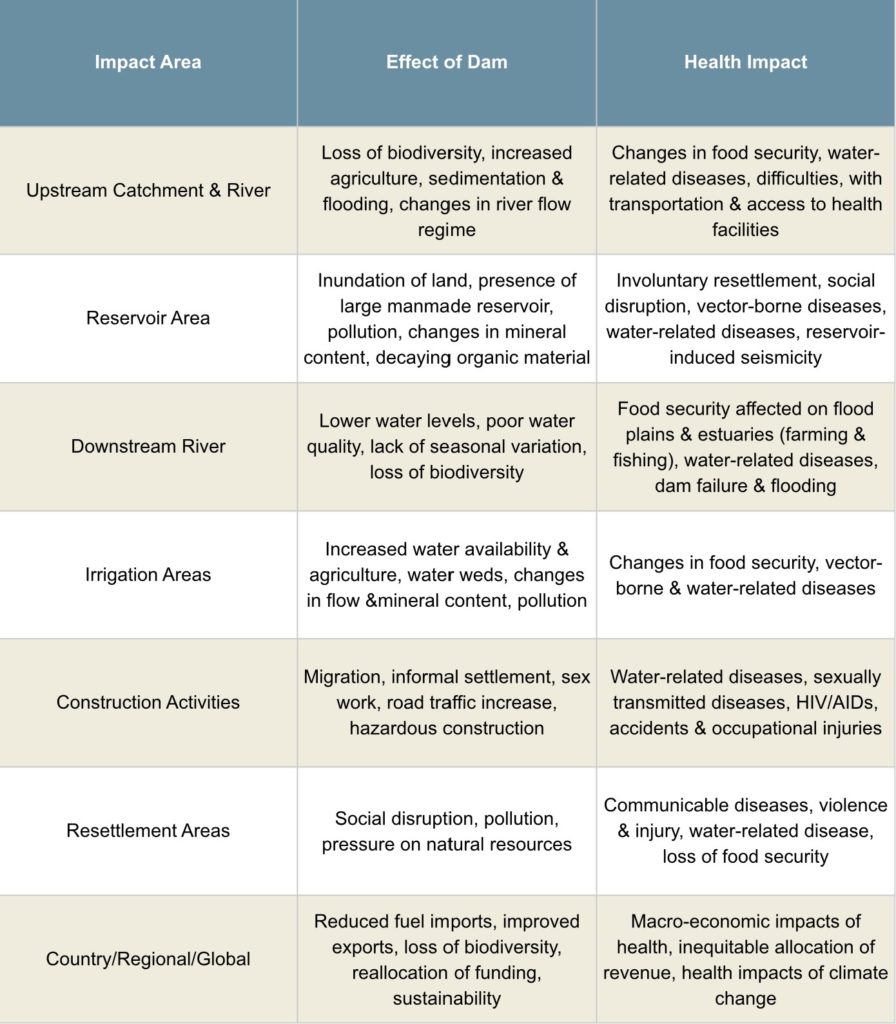
Data adapted from L. B. Lerer and T. Scudder, 1999.
Although hydroelectric power plants do not produce air pollution, they create water pollution in the form of heat and chemical pollutants. Hydroelectric dams are often a source of polychlorinated biphenyls (PCBs).6 Plasma taken from fish in the Columbia River have been found to contain all 18 of the chlorinated pesticides for which tests were conducted.4 These chemicals are dangerous to all aquatic life, including salmonids, as well as humans living downstream from these dams. Most notably these chemicals have affected Native American populations who depend heavily on the Columbia River Basin for fish. As a result of biomagnification, those individuals who consume fish taken from the Columbia River Basin are exposed to concentrations of contaminants such as PCBs, arsenic, and mercury.
Hydroelectric power plants provide a clean, renewable alternative to fossil fuels for generating electricity. Nevertheless, hydropower can affect the environment in a many ways that are detrimental to local fish and human populations. These factors must be carefully considered before installing a hydroelectric dam. Fortunately, scientists and engineers are continuously researching new methods of producing hydroelectric power which minimize the potential harm to the environment.
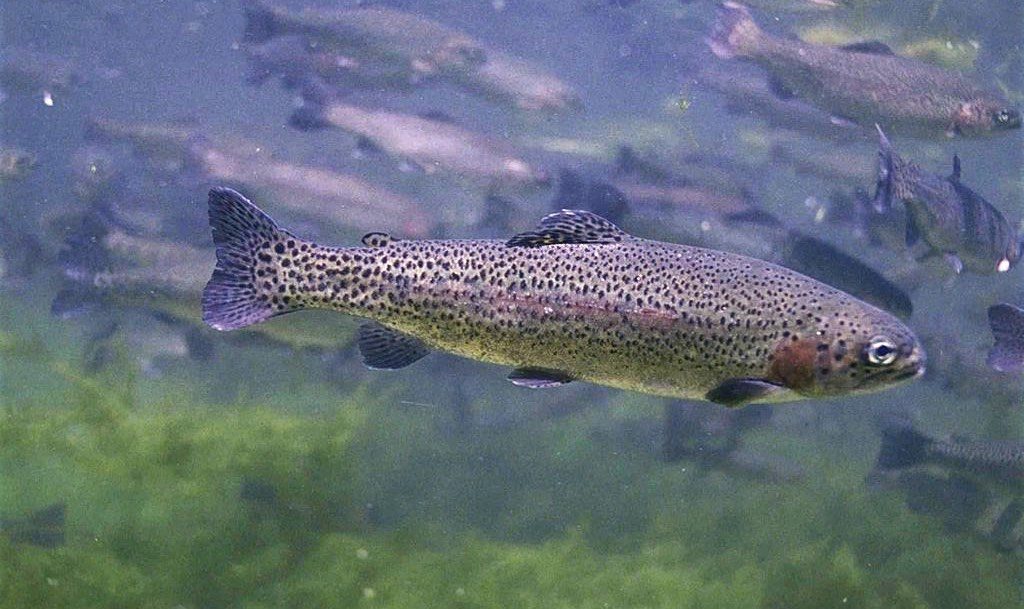
Rainbow trout are greatly affected by the water levels within the Grand Coulee Dams reservoir (also known as the Franklin D. Roosevelt Lake).
Photograph by Eric Engbretson, 2013. Public Domain.
References
- Barbour, G.B. (1940). Harnessing the Columbia River: The Grand Coulee Dam and Its Geographical Setting. The Geographic Journal, 96:233-242.
- Dauble, D.D. et. al. (2011) Impacts of the Columbia River Hydroelectric System on Main-Stem Habitats of Fall Chinook Salmon. North American Journal of Fisheries Management, 23:641-659.
- Energy 101. (2013 April 19) [Video discussing the science behind hydroelectric power generation]. U.S. Department of Energy. Retrieved from http://www1.eere.energy.gov/water/hydropower_resources.html
- Feist, G.W. et. al. (2005). Evidence of Detrimental Effects of Environmental Contaminants on Growth and Reproductive Physiology of White Sturgeon in Impounded Areas of the Columbia River. Environmental Health Perspectives, 133:1675-1682.
- Grand Coulee Dam. (April 3, 2014). U.S. Department of the Interior.
- Hinck, J.E. et al. (2006). Environmental contaminants and biomarker responses in fish from the Columbia River and its tributaries: Spatial and temporal trends. Science of the Total Environment, 366:549-578.
- Horn, F.J., & Johrde, P. S. (1975). Electrical and mechanical design features of the 615 MVA generators for Grand Coulee Dam. IEEE Transactions on Power Apparatus and Systems, 94(6):2015-2022.
- Lerer, L.B. & Scudder, T. (1999). Health impacts of large dams. Environmental Impact Assessment Review, 19:113-123.
- McClung, C. (2009). Grand Coulee Dam: Leaving a Legacy, University of Washington. Retrieved from http://depts.washington.edu/depress/grand_coulee.shtml
- McLellan, H.J. et. al. (2011) Effects of Reservoir Operations on Hatchery Coastal Rainbow Trout in Lake Roosevelt, Washington. North American Journal of Fisheries Management, 28:1201-1213.
- Perlman, H. (2013 March 6). Hydroelectric power: How it works. USGS – U.S. Geological Survey.
- Erickson, Gregg M. (2009). Grand Coulee Dam. [Photograph]. Retrieved from Wikimedia Commons. CC BY 3.0.
- OSU Special Collections & Archives. (2004). Fall Chinook Salmon. [Photograph]. Retrieved via Wikimedia Commons.© 2015, Special Collections & Archives Research Center. Public Domain.
- U.S. Army Corps of Engineers. (2012). Water Turbine. Retrieved via Wikimedia Commons. Public Domain.
- Engbretson, Eric, U.S. Fish and Wildlife Service. (2013). [Photograph of Rainbow Trout]. Retrieved from Wikimedia Commons. Public Domain.
